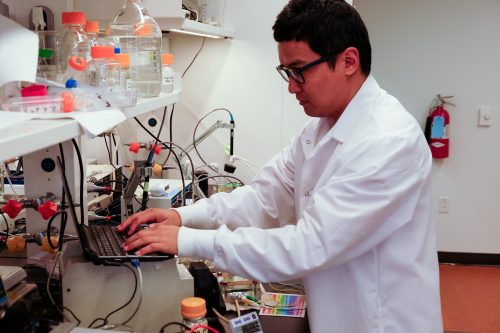Fishing can be quite the challenge, even for the experienced fisherman. The challenge of removing every live fish from the ocean thus seems rather silly. It becomes even more difficult when the problem is scaled down to the world of microorganisms. Nevertheless, this is essentially the challenge researchers in the Elimelech Lab at Yale University and the Wang Lab at Shandong University have been tackling for years as they attempt to remove antibiotic-resistant bacteria from wastewater. Their new answer? Zap them!
Overuse of antibiotics in agriculture and in medicine have greatly increased the risk of superbugs, bacteria resistant to a broad spectrum of antibiotics, and the continues to worsen. These antibiotic resistant bacteria accumulate in soil, drinking water sources, and wastewater, where they are particularly concentrated. Most current wastewater treatment methods, usually involving adding chemicals, are of limited efficacy and have no specific measures for targeting antibiotic resistant bacteria. The result is an accumulation of resistant and potentially pathogenic bacteria in water supplies.
In a recent paper published in the American Chemical Society’s Environmental Science and Technology, the group removed antibiotic-resistant microbes from wastewater using photocatalysis membrane technology, a process which separates microbes with a membrane and kills them under ultraviolet (UV) light. While membranes have been used in the past for wastewater treatment, there were problems with this design, which the new, photocatalysis membrane seeks to solve, explained Yunkun Wang, an assistant professor at Shandong University.
“Even if you use a filter, they will accumulate on the membrane surface and can still transfer antibiotic resistance genes,” said Wang.
Another powerful benefit of the new filtration technology is its ability to treat massive amounts of water quickly, which typical UV and chemical sterilization techniques do rather inefficientlyEven standard membrane technologies have this issue of scalability because the buildup of debris eventually decreases water flow through the membrane.
The new photocatalytic method uses a polyvinylidene fluoride (PVDF) membrane, a type of membrane woven with holes around 16 nanometers in diameter. Most bacteria are around two micrometers long, more than a thousand time bigger than these holes and therefore unable to pass through. The PVDF membrane is covered with titanium oxide, which gives it photocatalytic properties and decreases the average pore size to approximately six nanometers.
When UV rays hit the titanium oxide, they generate reactive oxygen species, unstable oxygen atoms prone to reacting with nearby molecules. These reactive oxygen species kill bacteria caught on the membrane by smashing apart their membranes.
Even more significantly, Wang and his colleagues found that they were also able to break apart the sequences of DNA responsible for making bacteria resistant to antibiotics. When they tested wastewater before and after being run through the photocatalytic membrane, they found up to one thousand times fewer copies of the antibiotic resistance genes in the filtered water, although this varied for different genes and their locations within the cells. Genes called integrons, that help bacteria pick up antibiotic resistant genes, were also found to be degraded.
They further tested the ability of the membrane to remain debris free, a property called antifouling. Although titanium-treated membranes have much smaller holes than regular PVDF membranes, the photocatalytic membranes can clean themselves by breaking up trapped debris and bacteria with UV light. Titanium oxide-treated membranes were found to recover original flux much better than untreated membranes.
Despite the promise of such technology, Wang remains realistic about its implementation in wastewater treatment facilities or in water treatment in the near future.
“This kind of surface coating is a little expensive. If we can find some other method that is very cheap, routine, and easy, it would be better for sure.” He further points out that some wastewater is colored or opaque, blocking UV light from the membrane. However, he sees a lot of potential for electrochemical membranes, a closely related strategy not involving UV light. While questions and barriers remain in regards to the implementation and further study of membrane electrochemical ultrafiltration, it’s also clear our microorganism fisherman have made progress—bacteria beware.

